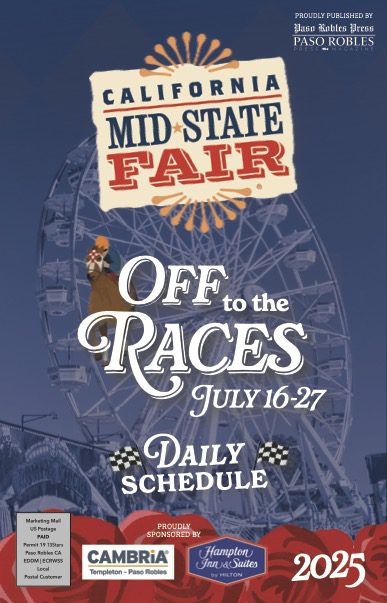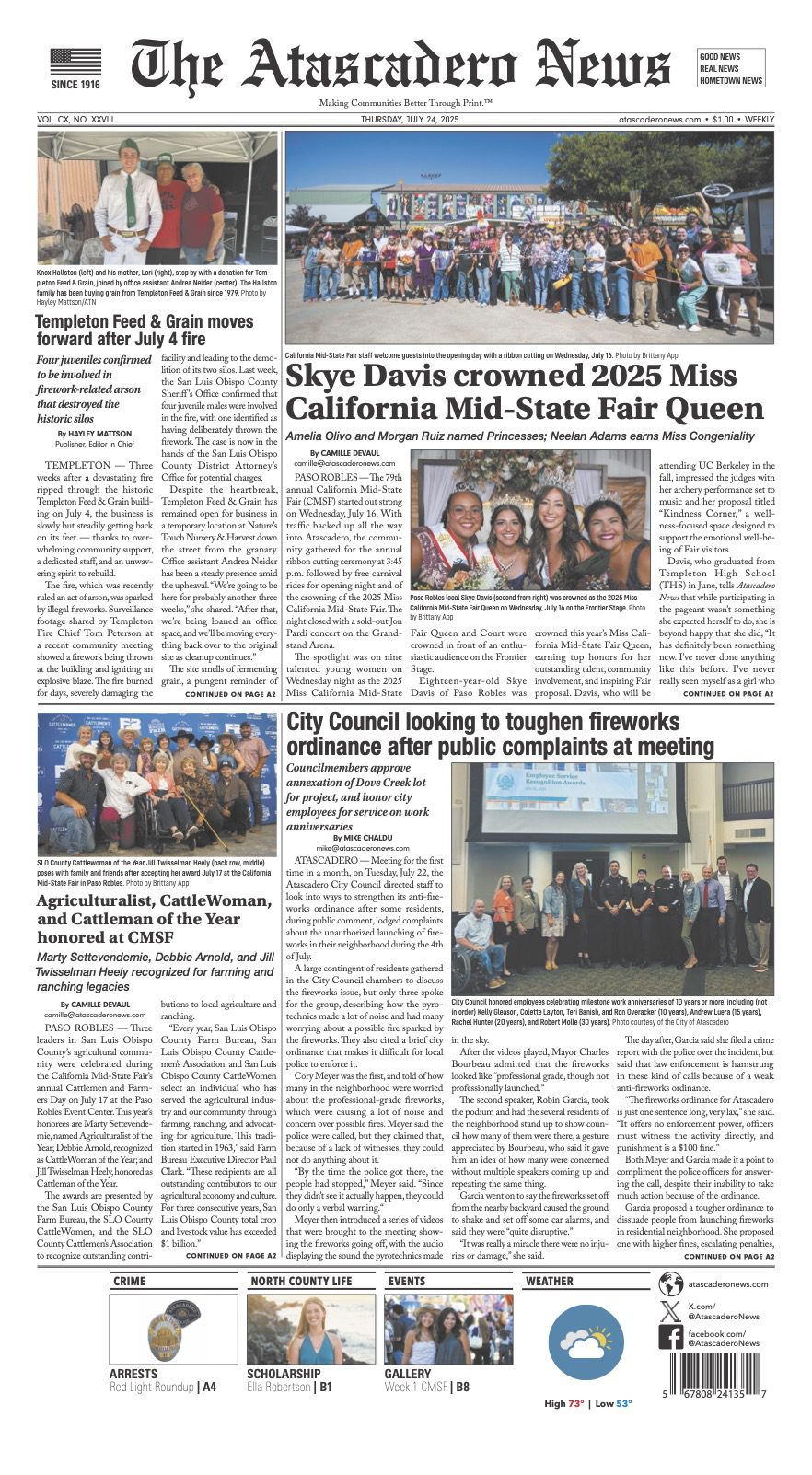Atascadero’s Charles Paddock Zoo is home to dozens of different species of animals, from an aviary full of a variety of birds and a reptile house featuring turtles, lizards, snakes and more to a wide array of mammals from small to large including full-grown Malayan tiger. Listed below are a few of our favorite critters to visit at the zoo along with a few fun facts about each one:
The Malayan Tiger
One of the most popular attractions at the Charles Paddock Zoo, the Malayan tiger is a tiger subspecies that is native to the southern and central parts of the Malay Peninsula and is an endangered species with an estimated 493-1,480 remaining in the wild. The Malayan tiger subspecies was first designated as being a seperate tiger species from the Panthera tigris corbetti in 2004 when genetic analysis found that it was a
distinct species.
Unlike many other cat species, the Malayan tiger enjoys playing in water and can often be found taking a dip in his pool at the zoo when the temperatures begin to rise. The tiger tends to like to take naps during the day so an early morning or late afternoon visit is your best bet to see this big guy in action.
The tiger has always been an icon of the Charles Paddock Zoo and was even immortalized at the zoo’s entrance with a huge bronze statue created by local artist Susan Beatie that overlooks the flamingo pond.
To find the tiger, make a hard right just past the gift shop after you enter the zoo. The Malayan tiger will be the first exhibit on your right.

The Slender-Tailed Meerkat
Located right in the center of the zoo, the Meerkat enclosure provides plenty of space to get up close and watch these entertaining little guys scurry about, popping in and out of holes and a hollow log. Originally from the deserts of Namibia, Angola and South Africa, the Meerkats are a type of mongoose and are almost always fun to watch. One of their interesting behaviors includes designating a member of their clan to serve guard duty while the rest forage for food. The meerkats take turns serving one-hour shifts as sentries. They are also known for their eclectic diet which can include everything from insects and eggs to lizards, small mammals and even birds. The meerkats are immune to certain types of venom which allows them to eat certain kinds of snakes and scorpions that are not edible to other species. They are also able to survive in the wild without water, hydrating themselves by eating fruit and tubers.

Red Panda
It’s always been frustrating trying to get a good look at one of the zoo’s more exotic residents, the mostly nocturnal red panda — a native of the eastern Himalayas and southwestern China. But the newly constructed Thelma Vetter Red Panda Experience should help to give visitors a better look. Opening to the pubic at the beginning of 2019, the exhibit was made possible by a generous donation from the estate of former Atascadero resident Thelma Vetter and is the first new exhibit built at the zoo in nearly four decades and the first exhibit built under the zoo’s “biodiversity hotspot” plan that will group exhibits based on their geographical area of origin.
Also known as a “shining cat,” the Red Panda is not actually a panda but a relative of the raccoon, skunk and weasel. However, like the unrelated giant panda, red pandas also have a diet consisting mostly of bamboo although they’ve also been known to eat mushrooms, roots, acorns, grasses and even fish, insects and other small mammals.
Red Pandas are listed as an endangered species with less than 10,000 individuals in the wild, due mostly to habitat loss caused by deforestation due to cattle ranching.

Black-Handed Spider Monkey
Located in the tall cages near the center of the zoo, adjacent to the Meerkat exhibit, the black-handed spider monkey is one of the zoo’s most vocal residents. Spider monkeys have a highly developed larynx, giving them the ability to produce a wide range of vocalizations, from bird sounds to barks and grunts.
Native to Central America, the spider monkey loves to interact with zoo visitors and is fun to watch as he quickly swings and climbs around his enclosure. This type of monkey is arboreal, meaning that they rarely come down to the ground and prefer to spend their time in the forest canopy foraging for insects, nuts, seeds, flowers and eggs.
Radiated Tortoise
The endangered radiated tortoise, a native of Madagascar, is one of the rarest subspecies of tortoise and is adorned with bright yellow lines radiating from the center of each carapace on its shell. Their habitat is disappearing due to destruction caused by humans and also because they are often the victims of poachers seeking their beautiful shells.
These gentle giants (each tortoise can weigh up to 35 pounds) are herbivores and enjoy munching on fruits, veggies and even succulents and cacti.
Like a tree, the radiated tortoise adds rings to its shell as it ages. Its shell also has blood vessels and nerves and the tortoise can feel when it’s being touched.
The radiated tortoise can be found all the way at the back of the zoo. From the entrance, veer left and continue past the parrots and king vulture.
Gila Monster
The largest lizard that is native to the United States, the Gila Monster can grow up to two feet in length and a weight of up to five pounds. These creatures, easily identified by their bright pink, orange and yellow patterns are found across the deserts of the southwestern U.S. and are named after the Gila River in Arizona where they were first discovered.
These large lizards are venomous and have even been known to be deadly to humans. They secrete venom through a row of glands in their lower jaw and administer the venom with a bite. Like snakes, Gila monsters also swallow their food whole without chewing. Unlike most predators, the Gila monster has poor eyesight and hunts using its sense of taste and smell.
The zoo’s Gila monster is located in the reptile house. Take a slight right after entering the zoo and passing the gift shop, then continue past the Prevost’s squirrel and burrowing owl exhibit to find the reptile house.
Scarlet Macaw
The open, fenceless parrot exhibit at the Charles Paddock Zoo provides an unobstructed, close-up view of these colorful birds, the largest of which is the Scarlet Macaw parrot. The macaw has creamy white, almost featherless face with bright red feathers covering most of its body along with brilliant blue and yellow feathers on the lower wings.
The scarlet macaw is native to a large section of North, Central and South America and can be found from southern Mexico all the way to Brazil and the island of Trinidad. Macaws are highly familial, preferring to spend their time in large groups, mating for life and spending hours every day with their mate and children, preening one another and removing bugs from feathers.
Macaws like to eat leaves, berries and seeds foraged from the rainforest and also have specialized beaks that allow them to crack tough nuts and a long, sticky tongue that allows them to remove the nuts once cracked.
You can find the parrot exhibit on your left after passing the zoo gift shop.
Caribbean Flamingo
A small flock of Caribbean flamingos greets visitors to the Charles Paddock Zoo with their pond located directly adjacent to the zoo’s entrance. The caribbean flamingo, a close relative of its cousins the giant flamingo and the Chilean flamingo, are the only flamingo species found in North America.
For flamingos, breeding success is based on synchronous nesting of the colony so that chicks hatch around the same time. So once per year, the colony puts on a show for zoo visitors, constructing large nesting mounds and nests before laying and hatching their eggs.
The flamingos’ distinctive goose-like honks can often be heard ringing across Atascadero Lake Park from the birds’ enclosure at the front of the zoo.
King Vulture
A large and intimidating creature, the king vulture is a bit of a bully in the bird world and has been known to chase other birds away from a scavenged carcass while it eats its fill. The bird’s aggressive attitude is one of the theories of how it the “king” part of its name. Found in Central and South America, the bird is the largest of the vulture species other than the two condor species.
The birds are striking in appearance with bright yellow-rose tinged white feathers and a large, very noticeable caruncle on its beak.
The king vultures can be found perched high above in their tall cage located in the back left corner of the zoo near the parrot exhibit. Remember to look up or you might miss them!
The Charles Paddock Zoo is located at 9100 Morro Road in Atascadero.
For more information, call 805-461-5080 or visit charlespaddockzoo.org











